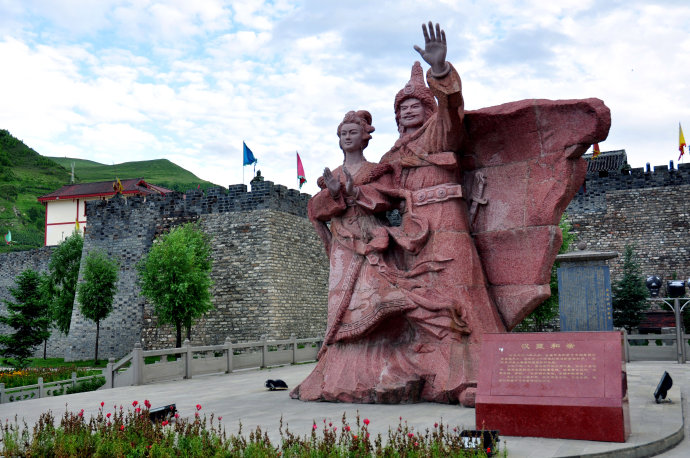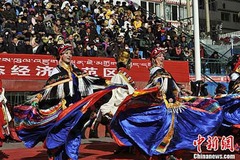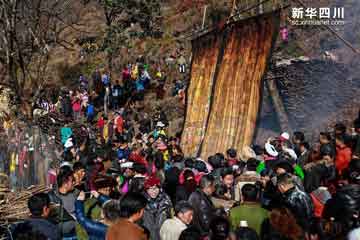Songpan's charm lingers and shines in modern times
Ernest Henry Wilson visited Songpan, an ancient city in Sichuan province, a few times beginning in 1903 to take back with him seeds to the United Kingdom.
Back then, Songpan used to be an important source of biodiversity because of its location near the origin of Minjiang River, between the Qinghai-Tibet Plateau and the Sichuan Basin.
During his visits, the late British botanist took many photos of the city and praised its weather, landscape, ethnic food and culture in eulogies.
Multiethnic Songpan in Southwest China retains its charm today.
The local government has installed a statue of Wilson to honor his contributions in making Songpan known to the world by way of photos and writings. They have also served as ready references for the authorities while rebuilding parts of the ancient structures other than the city's well-preserved wall.
Songpan was a hub for trade in tea, herbs, salt and cattle between western China and Central Asia, as well as a base for imperial China's military forces since the Tang Dynasty (AD 618-907).
The city's profile rose further in the early Ming Dynasty (1368-1644), when a general from northern China built a wall with many gates and watch towers.
Songpan's charm lingers and shines in modern times
The wall of black bricks, made from rocks of a nearby mountain, is more than 6 kilometers long and 12 meters high.
The watch towers are taller and broader compared with similar structures in Nanjing, the first Ming capital, in East China's Jiangsu province. The gates of the wall feature delicate stone carvings that date back 400 years.
Late Ming rulers consolidated the 60-year-old wall project, making Songpan one of the country's most impenetrable cities at the time.
The Red Army crossed Songpan from 1935-36 during their historic Long March. The communist troops were on their way to North China.
The city gates served as shelters from air raids during the War of Resistance Against Japanese Aggression (1937-45). On a gate in the wall that faces Wilson's sculpture, there are also some bullet holes made in 1944 by the Japanese forces as they targeted Chinese civilians.
Around the city are many ruins of ancient battlefields. In the Minjiang River Valley and Peijiang River Valley, travelers can easily spot mountain passes, barracks and beacon towers.
The city perches on a mountain slope with a river running through it. Most of the buildings in Songpan are in traditional Tibetan and Qiang styles, the two main ethnic groups in the region.
Songpan was an important spiritual destination in the past, as evident from more than a dozen Buddhist, Taoist and Confucian temples, as well as a few mosques.
About 57 kilometers to the east of Songpan is the Huanglong Scenic Area, a must-see spot for tourists. It is famous for its colorful calcified water bodies that are surrounded by primeval forests, near the origin of the Peijiang River. The color of water changes with sunlight and the seasonal changes in trees, creating a fantasy land.

Statues of ancient Tibetan king Songtsen Gampo and the princess guard the old city gate of Songpan in Sichuan province. [Photo/China Daily]
Your Comment
Name E-mailRelated News
-
;
-
-

-
Aba people in Sichuan Tibetan-inhabited area celebrates Losar
Gala is held to celebrate Losar in Aba Tibetan and Qiang autonomous prefecture of southwest China’s Sichuan Province on Jan. 22, 2016.
-
-
-

-
Buddha painting unfolding festival celebrated in Sichuan Tibetan-i
The Minyak people in Shimian Country of the Tibetan-inhabited area of Sichuan Province are celebrating the Buddha painting unfolding ceremony on Dec.
-
-
-

-
Amazing scenery in Sichuan Tibetan-inhabited areas
With an average elevation of 3,600 meters, the Jiangyuan County boasts vast expanses of grassland and forest as well as rich mineral resources, covering an area of 8,440 square kilometers.
-
Based in Lhasa, Tibet Vista is a Tibet travel agency that specialized in Tibet permit, and Tibet tours for both private and group travelers at a local price!
•4 Days Lhasa City Group Tour from USD 460 •8 Days Everest Base Camp Group Tour from USD 850 •15 Days Mt.Kailash Group Tour from USD 1780 •2016 Tibet Train Tours from Beijing, Shanghai, Chengdu, Xining,etc










